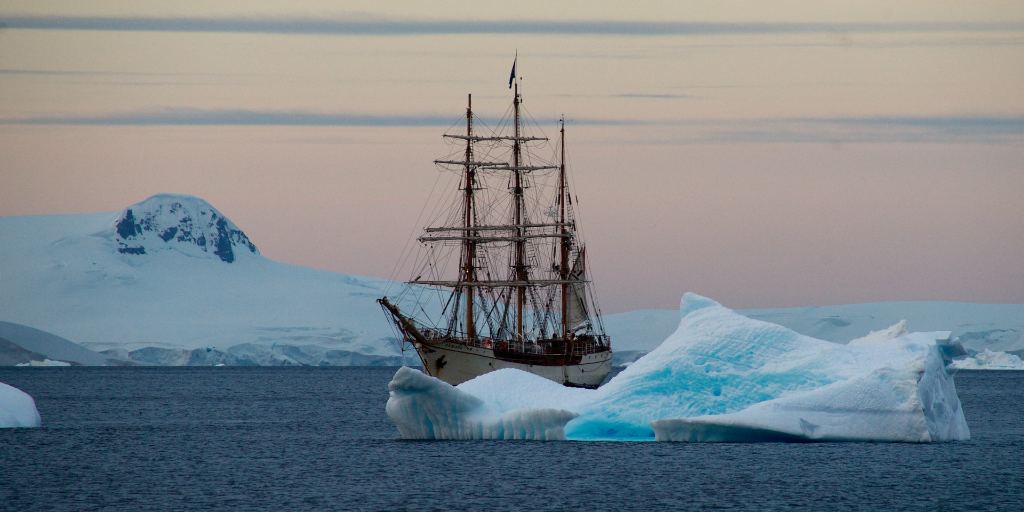A famous shipwreck is found off the coast of Antarctica
Lesson summary
Hi there everyone, I’m Jeff and you are listening to Plain English, where we help you upgrade your English with current events and trending topics. Today’s lesson is number 459, and JR has uploaded the full lesson to PlainEnglish.com/459.
Coming up today: Over one hundred years ago, an explorer’s ship sunk off the coast of Antarctica. Last month, a team of modern explorers found it while driving a Saab—I’ll explain. The expression we’ll discuss today is “eat away at” and we have a song of the week. Let’s dive in.
Shipwreck discovered near Antarctica
Ernest Henry Shackleton was one of the most famous Antarctic explorers. Born in Ireland, Shackleton grew up in the suburbs of London. Bored with school, he became an apprentice on a merchant sailing ship at age 16. In his early twenties, he joined an expedition to explore Antarctica. He and his fellow explorers became the first people to reach 82 degrees south latitude. A few years later, he reached 88 degrees south latitude, just about a hundred miles from the South Pole, which had never been reached by humans.
But then, someone else beat him to the ultimate prize. Roald Admunson, a Norwegian explorer, became the first person ever to reach the South Pole. Not to be outdone, Shackleton set his sights on another feat. He wanted to be the first person to cross Antarctica, end to end, over land. To do that, he proposed to sail to the Weddell Sea, deep in the South Atlantic Ocean. He would make landfall on Antarctica, cross the continent, pass South Pole, and finish on the Ross Sea, at the other end of Antarctica. He proposed to do it in dogsleds.
But it didn’t happen. Before Shackleton and his crew of 28 men could make landfall, their ship, the Endurance, got stuck in the ice in the Weddell Sea. For an entire winter, the ship drifted northward; the crew couldn’t do anything to dislodge the ship from the pack ice. Eventually, the ice crushed the ship; it sank 10,000 feet—about three kilometers—before resting on the icy ocean floor.
Amazingly, the crew survived. The crew had to camp out on the ice for months. Then, when the weather improved, Shackleton and five others traveled 800 miles in a rescue boat to reach the nearest inhabited island. From there, they were able to coordinate a rescue mission to save the remaining crewmembers still stranded on Elephant Island.
Last month, a team of modern-day explorers found the Endurance. It had been lost to history for over a century. Videos taken far below the ocean’s surface show that the ship landed upright on the sea floor. The wood is almost perfectly preserved, and the name “Endurance” is still clearly visible on the stern.
One of the scientists on the discovery mission said this was the best-preserved wooden shipwreck he’s ever encountered. The Endurance had a little luck. In other parts of the ocean, wood-eating worms would have slowly eaten away at the wooden hull. But, as scientists are discovering, there weren’t any wood-eating worms in the frigid waters off Antarctica. Some undersea creatures have made their homes there, though. They’re mostly filter feeders, or sea creatures that filter out nutrients from the sea water.
The discovery took a century, but it was aided by modern technology that Shackleton and his crew couldn’t even have dreamed of. The first challenge was to know where to go, and in this, the Endurance’s crew gave modern-day researchers valuable clues. The ship’s navigator was Frank Worsley and he kept meticulous records about where the Endurance went down, and how the crew managed to escape. Those records gave modern-day explorers the confidence to know that they could narrow down the search radius to something more manageable. Modern GPS and navigational tools made the exploration process much easier.
Knowing where to look is only part of the battle, however. The same ice that doomed the Endurance would prove to be a challenge even today. The Weddell Sea is almost permanently covered in thick ice. But explorers used an ice-breaking ship from South Africa to clear a pathway to the suspected site of the ship, and to keep ice from forming while they were searching the seabed.
The search of the sea floor is also getting easier. Saab, the former carmaker, produces an underwater exploration vehicle that can explore the ocean floor on its own; it can also be controlled remotely by researchers on the surface. Researchers sent the Saab Sabertooth underwater vehicle looking in the area where Worsley, the navigator, had pinpointed the wreck.
Two weeks into the expedition, they found it. It was only seven kilometers from where Worsley said it had gone down.
Photo and video evidence
The next time you run out of hot water in the shower, or the next time you get lost because Google Maps isn’t updated, just think of those guys on the Endurance, and how they camped for months on the ice and then had to escape to a nearby island.
You can see photos and videos of the ship. I’ll post a few to our Facebook group. You can join that by visiting PlainEnglish.com/Facebook , and that will take you to the Facebook group.
Sometimes I feel bad that I can’t post pictures and videos and such in the audio lesson. And so many pictures have rights attached to them, and I can’t use them on the web page. So when there’s something visual like this, I’m going to start posting pictures and additional links right in the facebook page. So if you want to see that, come join the group at PlainEnglish.com/Facebook.
Learn English the way it’s really spoken

